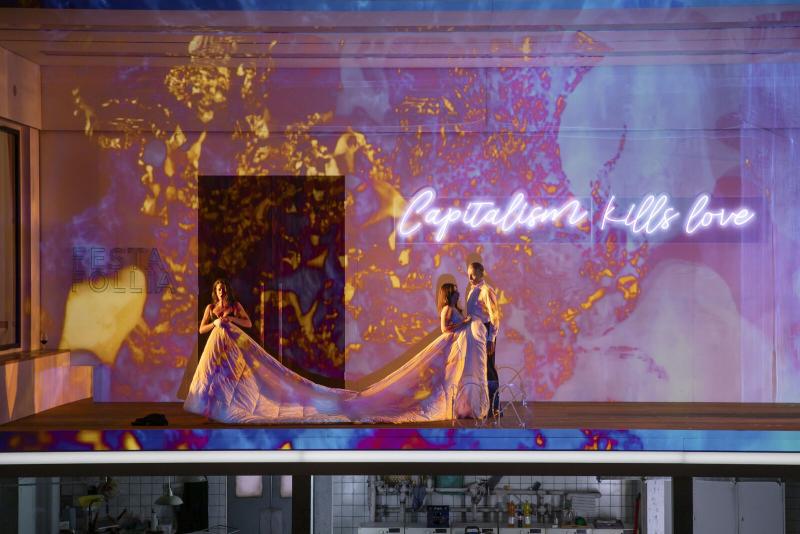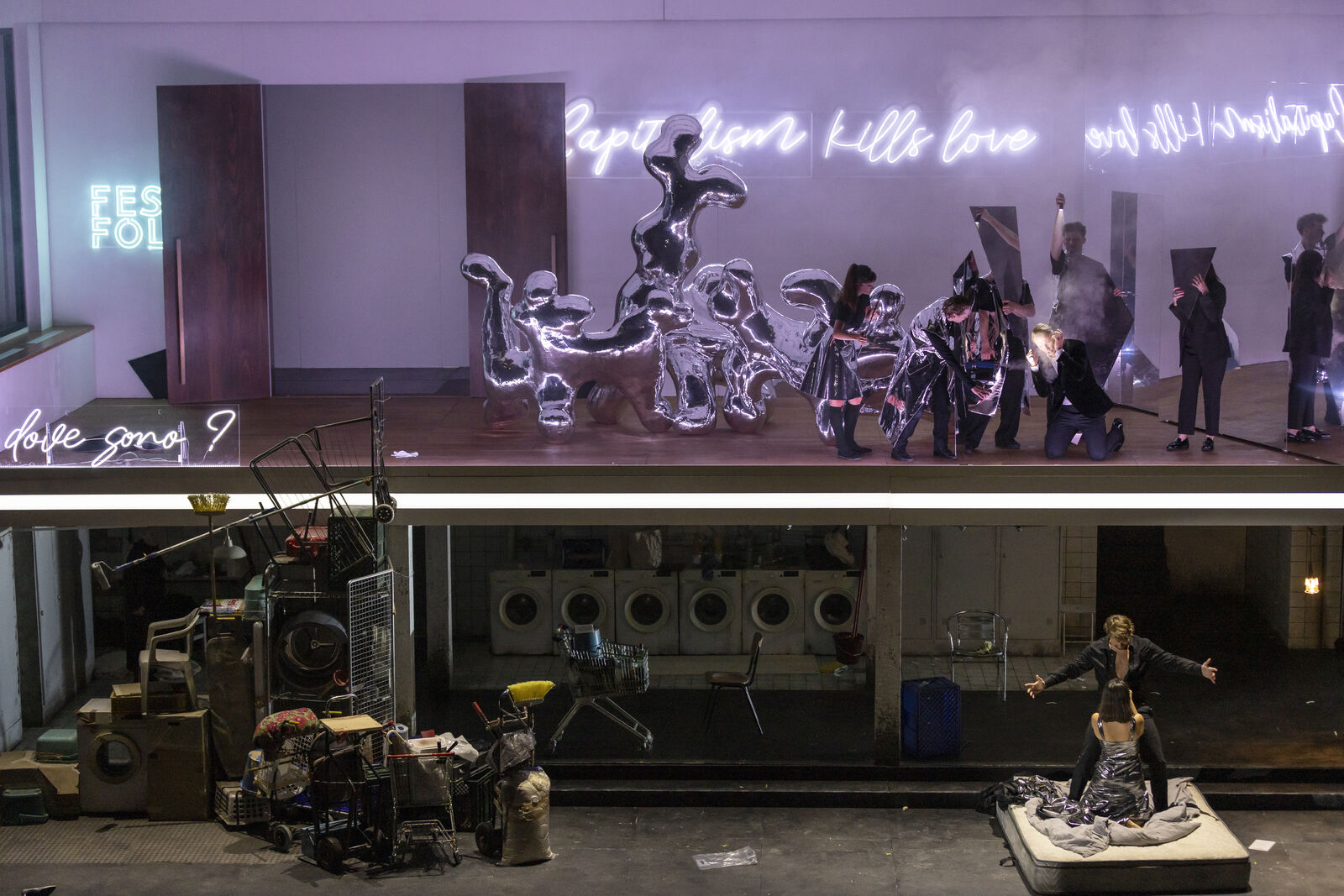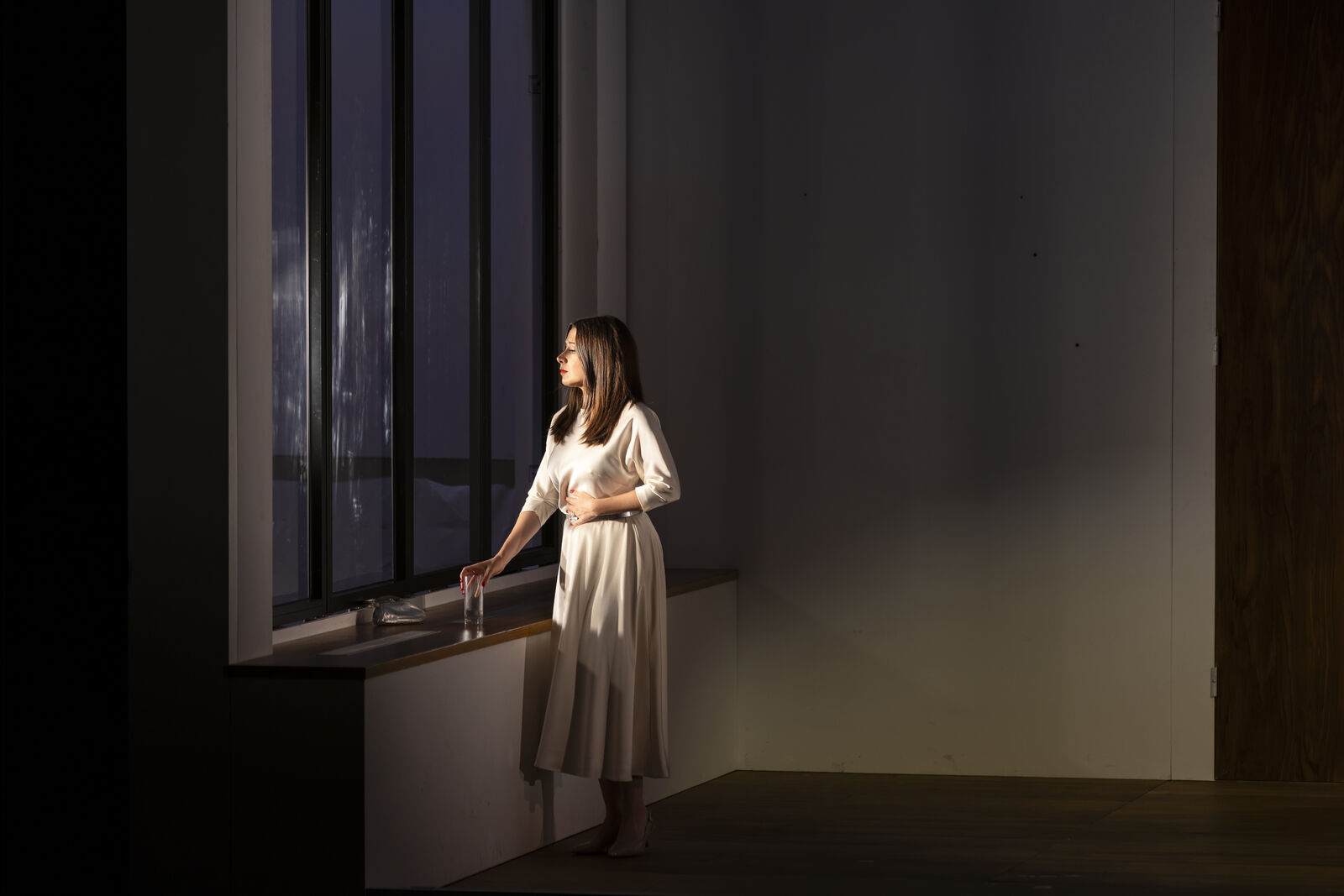Le nozze di Figaro, Komische Oper Berlin, Edinburgh International Festival 2024 review - great singing wasted | reviews, news & interviews
Le nozze di Figaro, Komische Oper Berlin, Edinburgh International Festival 2024 review - great singing wasted
Le nozze di Figaro, Komische Oper Berlin, Edinburgh International Festival 2024 review - great singing wasted
Entertaining in places, this is Kirill Serebrennikov’s piece, not Mozart’s

I’m all in favour of the EIF taking artistic risks, and of them bringing a high-prestige international production to Edinburgh. This Marriage of Figaro from Berlin’s Komische Oper is both of those things, because it is the first production by Kirill Serebrennikov – the high profile Russian director, placed under house arrest by the Putin regime, now based in Berlin – to be seen in the UK.
But the EIF agreed to host it before its Berlin premiere, and while they must have had their suspicions about how “radical” it was, I doubt they were prepared for just what a mess it turned out to be. For one thing, it didn’t fit the stage of the Edinburgh Festival Theatre. Serebrennikov divides the stage horizontally in an upstairs/downstairs model, but I heard lots of people in the theatre’s upper circle complaining that they couldn’t adequately see what was going on in the downstairs section. Maybe they were the lucky ones, because I could see it all and thought much of it was an unholy mess.  The stage’s division puts the Count’s home on the upper part with the servants’ grimy quarters beneath. The Almavivas’ house is full of expensive-looking contemporary art and in fact, by the time of Act 3, it isn’t clear whether it’s their home or in fact a gallery, as guest are shown around the exhibitions at the end of Act 3 during what should be the fandango. It’s a neat idea, if hardly an original one, to contrast the venal aristos with their put-upon servants; but Serebrennikov clearly doesn’t know what he’s trying to do with it. Is he trying to say the rich are nasty exploiters? If so, get to the back of the queue, Kirill: directors have been saying that for decades, especially at this house.
The stage’s division puts the Count’s home on the upper part with the servants’ grimy quarters beneath. The Almavivas’ house is full of expensive-looking contemporary art and in fact, by the time of Act 3, it isn’t clear whether it’s their home or in fact a gallery, as guest are shown around the exhibitions at the end of Act 3 during what should be the fandango. It’s a neat idea, if hardly an original one, to contrast the venal aristos with their put-upon servants; but Serebrennikov clearly doesn’t know what he’s trying to do with it. Is he trying to say the rich are nasty exploiters? If so, get to the back of the queue, Kirill: directors have been saying that for decades, especially at this house.
He clutters the stage with non-singing characters who, ironically, make a terrible racket with their actions. Cherubino becomes a mute character who can only communicate through Cherubina, a mezzo-soprano in love with him who translates his sign language for the other characters. Her presence does away with any need for Barbarina, incidentally. Furthermore, the music is cut up and spliced so that arias appear in places other than where Mozart intended them. Worse, the introduction to the "Dissonance" String Quartet appears in Act 4 and, most egregiously, Act 3 begins with the farewell trio from Così fan tutte.  It's entertaining at times, not least when you’re trying to guess what’s coming next, but the big unanswered question about the whole production is: why? I didn’t notice a single revelation from any of Serebrennikov’s directorial decisions, and some of the musical cut-and-paste must surely have been designed primarily to provoke rather than to enlighten. Most damagingly, all of this put a layer of distancing between the music and the audiences. Of all operas, this should be the one that should speak most directly to our human foibles and to our capacity for love and forgiveness, but this is fatally weakened when you’re busy wondering why a mass stabbing has just taken place in the art gallery, or whether the whole thing is taking place in the Count’s imagination.
It's entertaining at times, not least when you’re trying to guess what’s coming next, but the big unanswered question about the whole production is: why? I didn’t notice a single revelation from any of Serebrennikov’s directorial decisions, and some of the musical cut-and-paste must surely have been designed primarily to provoke rather than to enlighten. Most damagingly, all of this put a layer of distancing between the music and the audiences. Of all operas, this should be the one that should speak most directly to our human foibles and to our capacity for love and forgiveness, but this is fatally weakened when you’re busy wondering why a mass stabbing has just taken place in the art gallery, or whether the whole thing is taking place in the Count’s imagination.
There were musical consolations, with some really strong singing in the cast I saw, particularly from the ladies. Verity Wingate’s Countess (pictured below) was rich, creamy and luxurious, while Penny Sofroniadou’s Susanna was agile and bright. Karolina Gumos was young for a Marcellina, and invested a whole new energy into the character’s music, while Patirica Nolz did all she could with Cherubina. Hubert Zapiór gave a sexy virility to the Count’s music, while Peter Kellner’s Figaro was mischievous and vigorous. The Komische Oper orchestra sounded fantastic under conductor James Gaffigan, who kept everything moving with terrific zing, though how he was persuaded to go along with the textual jigsawing is a mystery to me.  None of this, however, made up for a theatrical experience that felt like cocking a snook at the audience in a way that Serebrennikov doubtless thought would be provocative but which ended up being just plain tedious. During Act 3 of the performance I saw, one audience member had clearly had enough and yelled out “Boo! Outrageous!” At least he cared. By that point I think I’m not sure I did any more.
None of this, however, made up for a theatrical experience that felt like cocking a snook at the audience in a way that Serebrennikov doubtless thought would be provocative but which ended up being just plain tedious. During Act 3 of the performance I saw, one audience member had clearly had enough and yelled out “Boo! Outrageous!” At least he cared. By that point I think I’m not sure I did any more.
Add comment
The future of Arts Journalism
You can stop theartsdesk.com closing!
We urgently need financing to survive. Our fundraising drive has thus far raised £49,000 but we need to reach £100,000 or we will be forced to close. Please contribute here: https://gofund.me/c3f6033d
And if you can forward this information to anyone who might assist, we’d be grateful.

Subscribe to theartsdesk.com
Thank you for continuing to read our work on theartsdesk.com. For unlimited access to every article in its entirety, including our archive of more than 15,000 pieces, we're asking for £5 per month or £40 per year. We feel it's a very good deal, and hope you do too.
To take a subscription now simply click here.
And if you're looking for that extra gift for a friend or family member, why not treat them to a theartsdesk.com gift subscription?
more Opera
 Albert Herring, English National Opera review - a great comedy with depths fully realised
Britten’s delight was never made for the Coliseum, but it works on its first outing there
Albert Herring, English National Opera review - a great comedy with depths fully realised
Britten’s delight was never made for the Coliseum, but it works on its first outing there
 Carmen, English National Opera review - not quite dangerous
Hopes for Niamh O’Sullivan only partly fulfilled, though much good singing throughout
Carmen, English National Opera review - not quite dangerous
Hopes for Niamh O’Sullivan only partly fulfilled, though much good singing throughout
 Giustino, Linbury Theatre review - a stylish account of a slight opera
Gods, mortals and monsters do battle in Handel's charming drama
Giustino, Linbury Theatre review - a stylish account of a slight opera
Gods, mortals and monsters do battle in Handel's charming drama
 Susanna, Opera North review - hybrid staging of a Handel oratorio
Dance and signing complement outstanding singing in a story of virtue rewarded
Susanna, Opera North review - hybrid staging of a Handel oratorio
Dance and signing complement outstanding singing in a story of virtue rewarded
 Ariodante, Opéra Garnier, Paris review - a blast of Baroque beauty
A near-perfect night at the opera
Ariodante, Opéra Garnier, Paris review - a blast of Baroque beauty
A near-perfect night at the opera
 Cinderella/La Cenerentola, English National Opera review - the truth behind the tinsel
Appealing performances cut through hyperactive stagecraft
Cinderella/La Cenerentola, English National Opera review - the truth behind the tinsel
Appealing performances cut through hyperactive stagecraft
 Tosca, Royal Opera review - Ailyn Pérez steps in as the most vivid of divas
Jakub Hrůša’s multicoloured Puccini last night found a soprano to match
Tosca, Royal Opera review - Ailyn Pérez steps in as the most vivid of divas
Jakub Hrůša’s multicoloured Puccini last night found a soprano to match
 Tosca, Welsh National Opera review - a great company reduced to brilliance
The old warhorse made special by the basics
Tosca, Welsh National Opera review - a great company reduced to brilliance
The old warhorse made special by the basics
 BBC Proms: The Marriage of Figaro, Glyndebourne Festival review - merriment and menace
Strong Proms transfer for a robust and affecting show
BBC Proms: The Marriage of Figaro, Glyndebourne Festival review - merriment and menace
Strong Proms transfer for a robust and affecting show
 BBC Proms: Suor Angelica, LSO, Pappano review - earthly passion, heavenly grief
A Sister to remember blesses Puccini's convent tragedy
BBC Proms: Suor Angelica, LSO, Pappano review - earthly passion, heavenly grief
A Sister to remember blesses Puccini's convent tragedy
 Orpheus and Eurydice, Opera Queensland/SCO, Edinburgh International Festival 2025 review - dazzling, but distracting
Eye-popping acrobatics don’t always assist in Gluck’s quest for operatic truth
Orpheus and Eurydice, Opera Queensland/SCO, Edinburgh International Festival 2025 review - dazzling, but distracting
Eye-popping acrobatics don’t always assist in Gluck’s quest for operatic truth
 MARS, Irish National Opera review - silly space oddity with fun stretches
Cast, orchestra and production give Jennifer Walshe’s bold collage their all
MARS, Irish National Opera review - silly space oddity with fun stretches
Cast, orchestra and production give Jennifer Walshe’s bold collage their all

Comments
That agrees very much with my
That agrees very much with my thoughts during and after the performance: